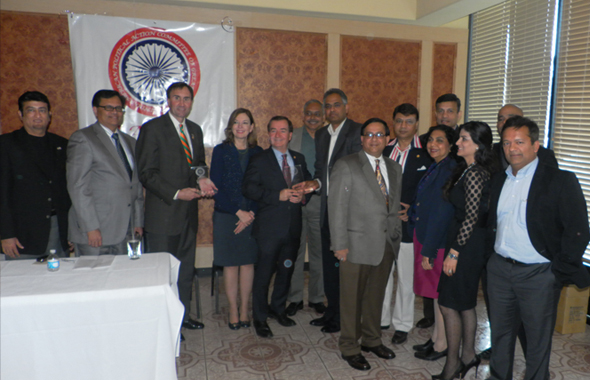IAPAC Holds an Easy Dialogue with A Congressman Who Knows India Well

California Congressman Ed Royce and his wife Marie received a plaque from IAPAC President Sujeeth Draksharam at Mayuri restaurant during a brief stopover in Houston this past Saturday, May 11 as members of the IAPAC Board and Texas Congressman Pete Olson look on. Photo: Jawahar Malhotra
By Jawahar Malhotra
HOUSTON: Despite being a Mother’s Day weekend and a pleasant Saturday afternoon ideal for outdoor activities, about 30 people made it to the Mayuri restaurant on Westheimer to listen to the two speakers that the Indo American Political Action Committee had invited to meet with the community on May 11.
One of the invited Congressmen, Ted Poe, a Republican from Texas District 2, was a no-show but the other two held an informal dialogue, mostly over the state of affairs between India and the US, but by extension, the role that that the local Indian population in the US can play as well as the impact of their numbers and economic prowess.
Congressman Pete Olson, a Republican from Texas District 22 which encompasses Sugar Land, Missouri City and Pearland, and no stranger to events that the IAPAC and the Indian community have organized, was ecstatic about the recent study by Rice University that reported that Sugar Land is the most diverse city in the US. In his usual light-hearted manner, with knees slightly bent as if to bring his tall frame down to eye level, he hammered that point in whenever he could to an appreciative crowd. But he also took credit for working with Indian Consul General Parvathaneni Harish to seal the deal to allow LNG to be exported to India from the still-to-be-retrofitted terminal at Sabine Pass.
But the show stopper for the afternoon was Congressman Ed Royce, a Republican from California District 39 which encompasses Orange County, just southwest of downtown Los Angeles, who made a stopover in Houston along with his wife Marie, at the urging of the IAPAC President Sujeeth Draksharam who had made the request when he and other IAPAC members visited Washington, DC late last year. “This visit is to thank them for their support,” said Royce.
Much shorter, in comparison to the over six-foot tall Olson, Royce is a towering figure in the Congressional hierarchy in his position as Chair of the Foreign Affairs Committee, from which he can steer US policy as it relates to India. He has had a lot of exposure to India, not just by virtue of his work, but also personally and joked that his wife, Marie, had even more experience when she was a VP at Choice Hotels and the Marriott where she regularly came into contact with the large percent of hotel/motel owners who are Gujarati.
“Jai Hind,” started out Royce, as he took off his coat and rolled up his shirtsleeves to grab the mic. He then went on to describe how India-US relations have evolved past the Cold War era when India was in the Soviet Union’s orbit to the present day when ties between India and the US have become inexorably intertwined, taking into account the purposeful economic reforms towards a capitalistic structure that India undertook two decades ago.
Royce impressed the audience with his command of the subject as well as his involvement in recovery efforts in the aftermath of the Gujarat earthquake in 2001 and the Mumbai 9/11 attacks in 2008. Having once stayed at the Taj Hotel in Mumbai, he was familiar with the area where the attack took place. He also was instrumental in having the US-India Civil Nuclear Agreement passed allowing India to proceed with using enriched Uranium for energy purposes.
“We need to increase focus to put India on the map of greater trade and investment,” said Royce. He also worried that Pakistan’s failure to suppress terrorist attacks would destabilize the region. Also on his mind was the revisions to the immigration bill that are working their way through Congress, a subject of the question and answer period that followed, with past IAPAC president Sanjay Rao reading from written questions submitted by the audience. Royce responded that he wasn’t aware that there was a bias against H1B visa applicants from India, with the number of visa allowed much less that those from other countries, as well as the much lengthier processing times which can run into several years.
Royce did, however, make it clear that he felt that Indians were better equipped to adapt and integrate into American life and contribute to the economic well being of the country. He is a proponent of allowing foreign students who graduate from American universities to receive their Green Cards upon graduating, thus allowing them to continue on with their careers here and becoming part of the force that can create new jobs in the US. Both he and Olson stressed that it was important to change the misconceptions associated with Indo-Americans and to fight in the political process for their presence in their adopted country.
